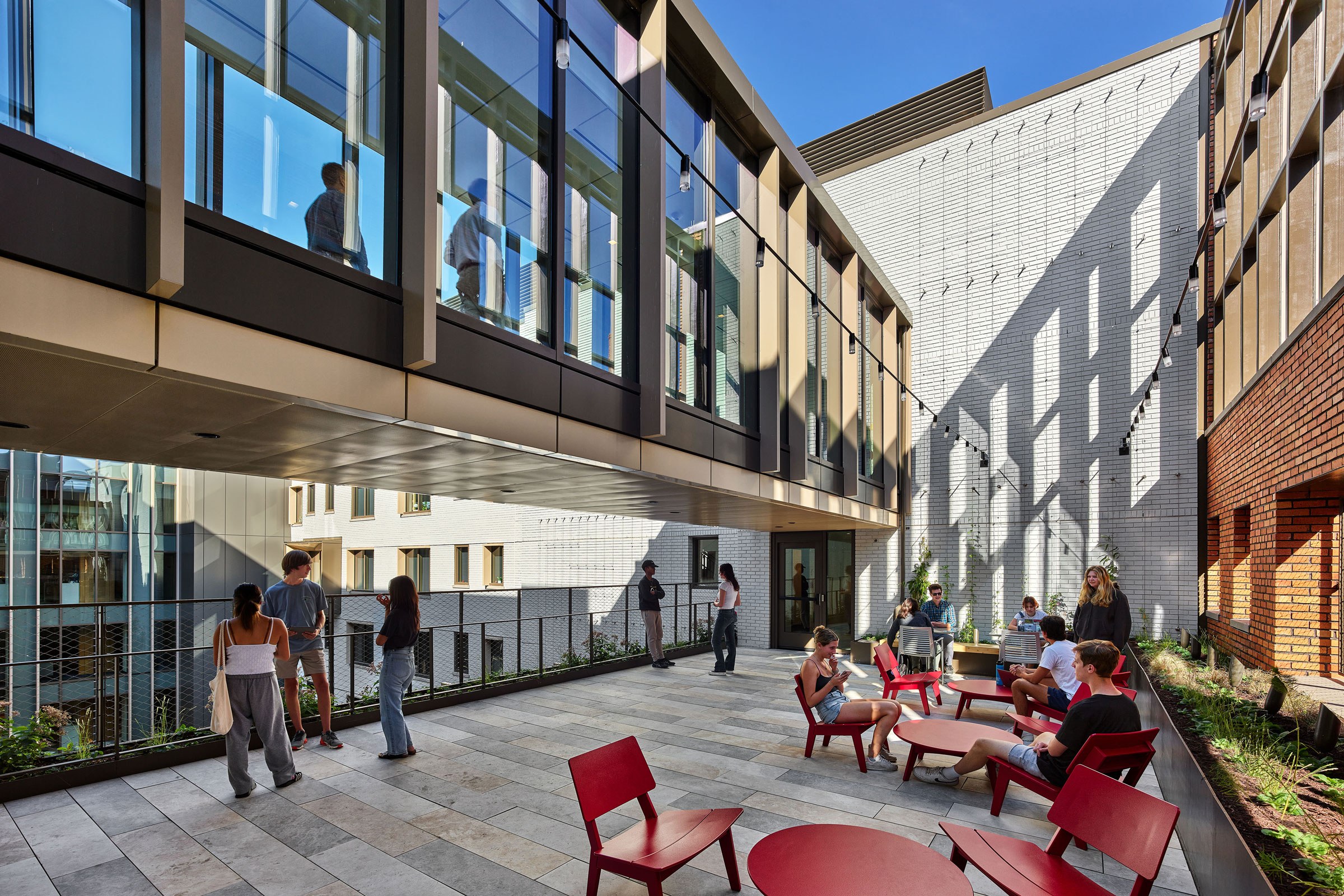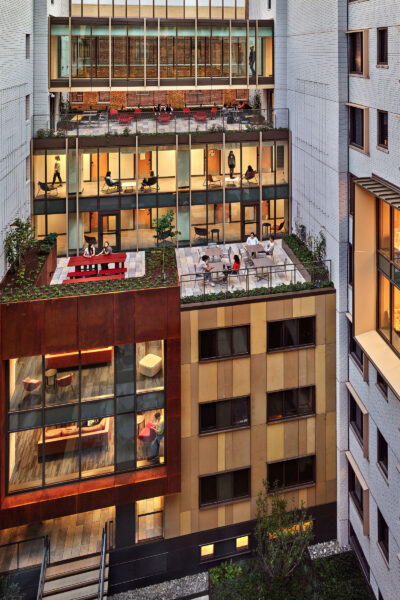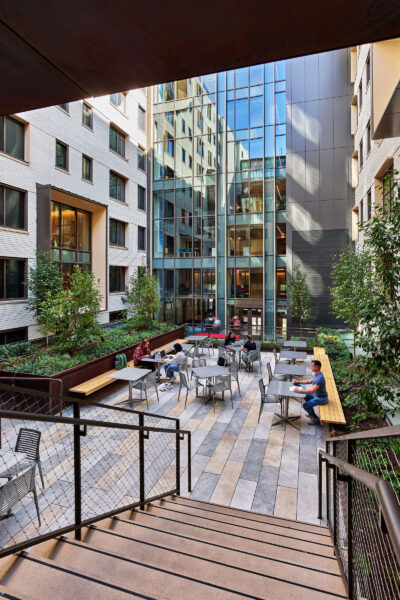Story at a glance:
- University projects are increasingly being built with outdoor spaces and areas for connection in mind.
- Studio Gang’s University of Kentucky Gray Design Building project is a standout example of adaptive reuse.
- McMillan Pazdan Smith helped to reinvent WCU’s Brown Dining Hall and greatly improve the building’s water and energy efficiency.
On average institutions of higher education in the United States produce 19.39 MTCO2E per 1,000 gross square feet annually, accounting for roughly 2% of all GHG emissions in the US. It may not seem like much to some, but there is room for improvement.
Universities can help fight climate change today by actively working to decarbonize their operations and focus on sustainable projects.
Here are 10 sustainable university buildings we love.
1. Gray Design Building Renovation, Lexington, KY

The revitalized facade of the Gray Design Building—where historic brick meets modern glass—exemplifies the seamless blend of past and future in Studio Gang’s adaptive reuse project. Photo by Tom Harris
Renovated by Studio Gang for the University of Kentucky’s College of Design, the Gray Design Building is an inspiring example of how adaptive reuse may be practiced in higher education.
Originally built in 1917 as a tobacco warehouse, the building now houses a cutting-edge, cross-disciplinary academic facility where students may learn, collaborate, and innovate for the future. “The opportunity to take something with an unhealthy association and transform it into a positive and optimistic space for future makers was an exciting aspect of this project,” Juliane Wolf, design principal and partner at Studio Gang, told gb&d in a previous publication.
To preserve the building’s character, many of the existing materials—like its timber beams and columns, exposed brick walls, and large windows—were kept, along with the structure’s roof, foundation, and skin. “We were able to reuse most of the existing building’s structural components, which greatly reduced the project’s embodied carbon,” Wolf says.
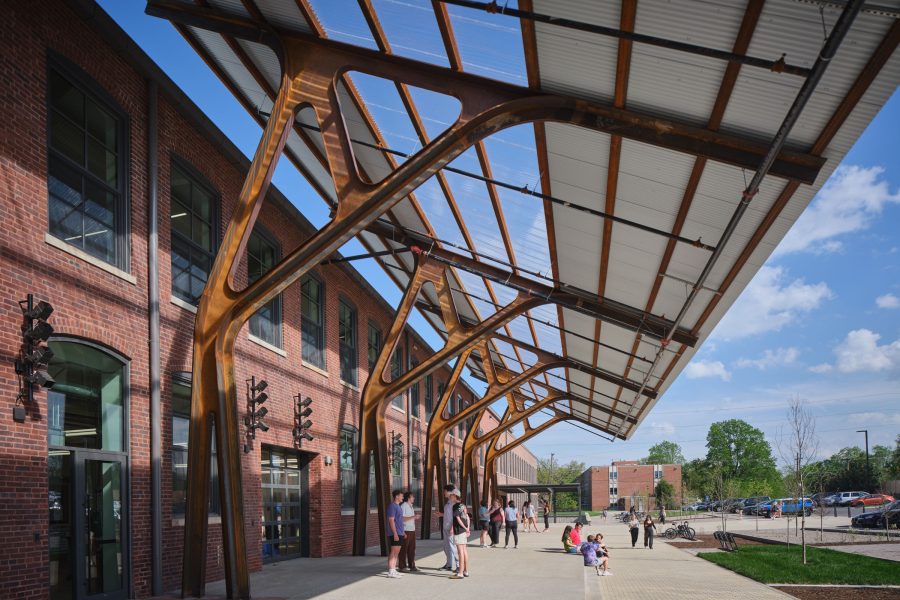
A new canopy featuring transparent panels and strategic gaps provides shade and promotes air circulation, creating a comfortable microclimate around the main entrance at the Studio Gang–designed Gray Design Building at the University of Kentucky. Photo by Tom Harris
The project’s commitment to sustainability extends beyond its reuse of existing materials. All of the building’s heating and cooling is supplied by a geothermal well located underneath the adjacent parking lot while transparent panels and strategically placed gaps in the structure’s envelope help provide passive illumination and ventilation respectively. New trees and a structural canopy were also added to the structure’s southwest-facing facade to provide shade, diminish heat gain, and provide passive cooling.
Inside, mobile pin-up walls demarcate each studio, allowing students to self-organize and collaborate with one another; a flexible classroom, double-height lecture hall, student gallery, and other shared spaces further encourage interaction and facilitate future adaptability.
2. Brown Dining Hall Renovation, Cullowhee, NC
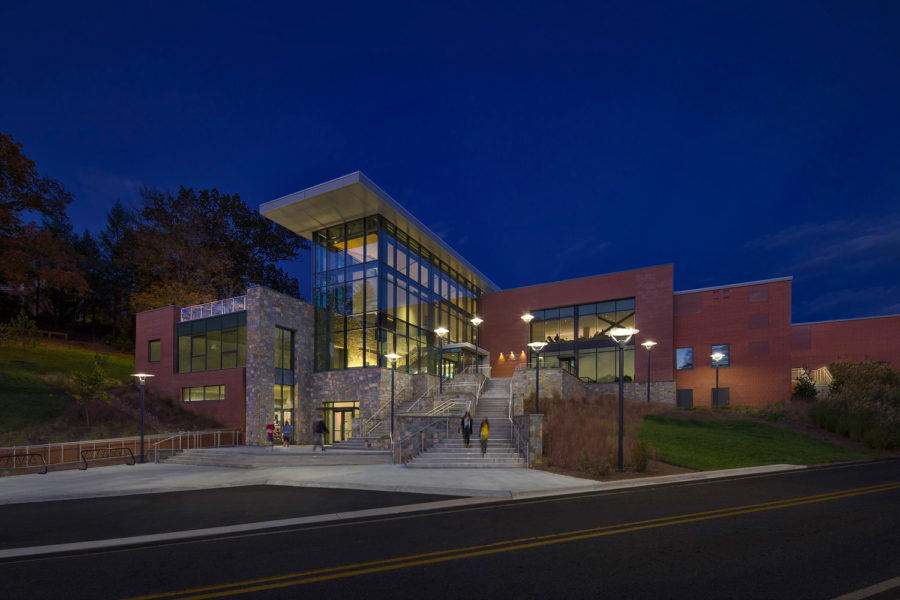
McMillan Pazdan Smith’s renovation of the Brown Dining Hall at WCU greatly improved the building’s water and energy efficiency. Photo by Gary Matson
Built in 1960, Brown Dining Hall has long served Western Carolina University (WCU), acting as its proverbial heart throughout much of its life. Over time, however, maintenance issues led the building to become underutilized and by 2015 the hall was little more than a glorified storage closet.
WCU considered demolishing the structure to make way for something new, but the building’s emotional significance ultimately caused stakeholders to push instead for renovation—something that would ultimately be more difficult, especially considering the university’s sustainability goals, but not impossible.
“While working through emerging obstacles and thinking outside the box to allow sustainability to be a driving force may be challenging at times, it can be done and done well, as Brown Hall exemplifies,” Jana Hartenstine, principal and design leader of McMillan Pazdan Smith—the firm in charge of the project—previously wrote for gb&d.
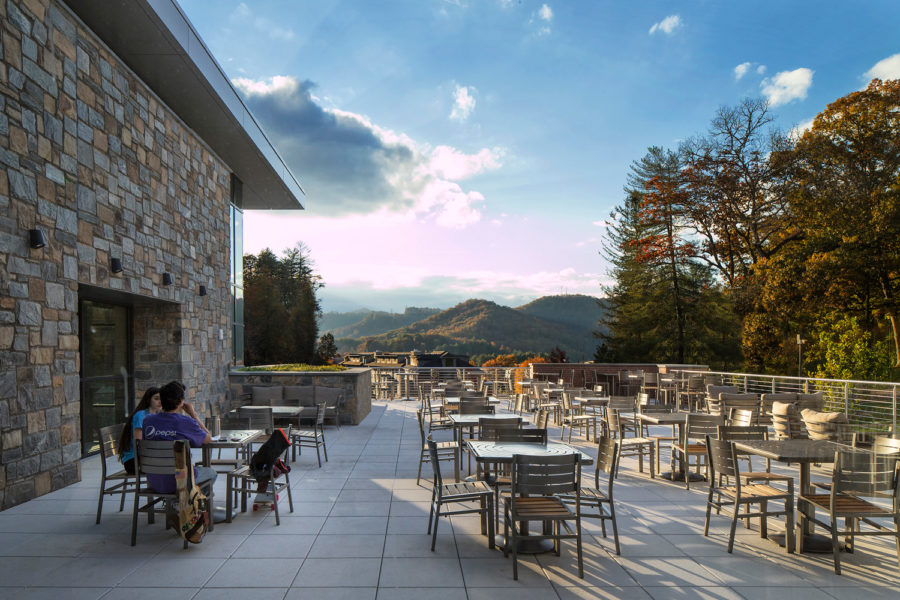
Students spend time at an outdoor dining area at Brown Dining Hall at WCU. Photo by Gary Matson
Despite the building needing additional structural reinforcement, the design team was able to reuse 94% of the original structural elements; out of the existing materials that were not able to be reused, 98% were recycled. Any new materials were selected in part for their low environmental footprint and non-toxic ingredients. “To support the university’s culture of ecological responsibility, all building materials were selected with LEED Gold certification in mind. All adhesives, paints, and sealants are low in volatile organic compounds,” writes Hartenstine.
Beyond thoughtful material selection, the building boasts several other sustainable features, including highly reflective roofs and hardscape elements (to help mitigate the urban heat island effect), LED lighting, and an extremely efficient zoned HVAC system with full economizer controls. The dining hall and main building make use of an air-cooled chiller with three air handling units, while individual ducted split system heat pumps supply heating and cooling to the hall’s commercial venues.
All in all, the Brown Dining Hall renovation was able to reduce the building’s annual energy consumption by 4% and its potable water usage by an estimated 42% below the baseline—despite nearly doubling the project’s total square footage.
3. UC Davis Admin Health Building, Rancho Cordova, CA
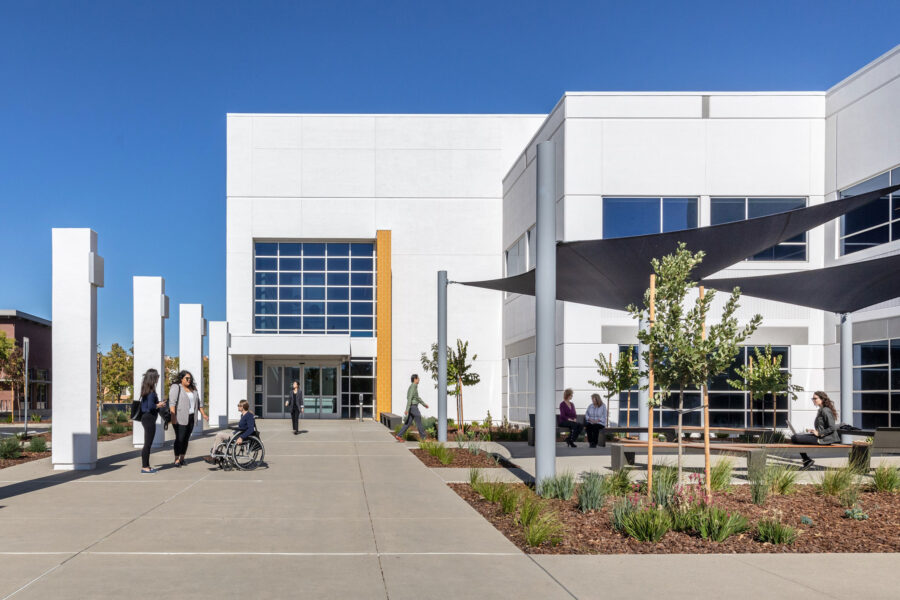
The all-electric UC Davis Health Admin Building project designed by Stantec allowed for a 58% reduction in embodied carbon as reuse versus a new build. The design was 31% more efficient than a standard ASHRAE baseline building. Photo by Kat Alves
Redesigned by Stantec to meet LEED Gold certification and the University of California’s Carbon Neutrality Initiative standards, the UC Davis Admin Health Building is an inspiring example of both adaptive reuse and modern biophilic design.
Built in the 1990s as a call center, the building was largely bereft of natural light and provided few open spaces for employees to socialize or gather. To remedy the daylighting issue, Stantec added new light wells and selected bright, neutral colors to help draw light into the interior. Outdoor patios and green spaces now provide employees with places to conduct informal meetings, work independently, or take a break from work and enjoy the fresh air, offering views of nature from every direction.
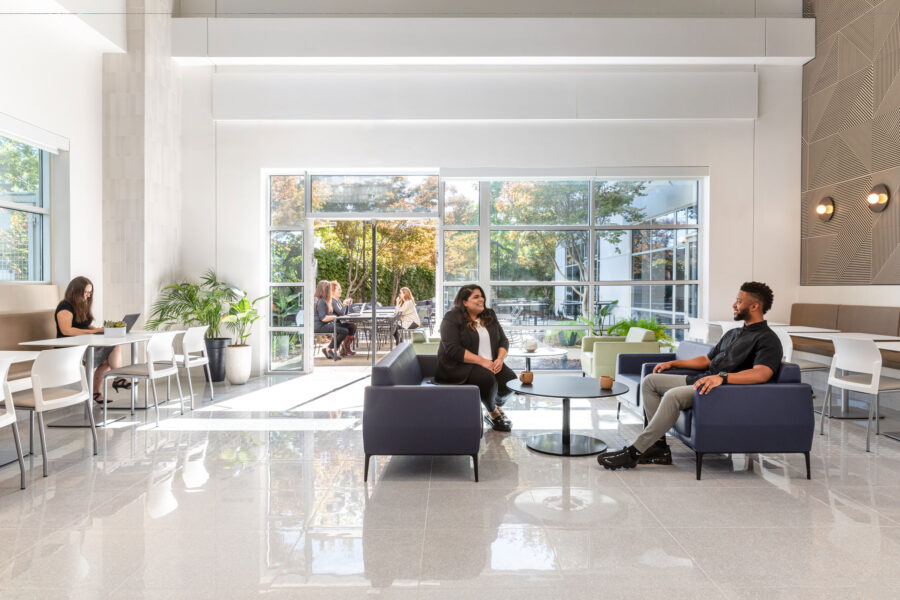
Incorporating the appearance of greenery, open natural light, and connectivity creates a sense of well-being and calm inside the UC Davis Health Admin Building. Photo by Kat Alves
“This building is surrounded on three sides by mature trees. While this is a more of a suburban setting, you can see from the cafeteria, we allow for views to this greenery,” Brian Crilly, design principal at Stantec, previously told gb&d. “That’s very important from the standpoint of human health, and that gets back to the textures and colors we’re using as well—a little bit more natural and not just white everywhere.”
Hanging and wall-mounted greenery provide pops of color throughout the interior while wood and wood-like textures—amongst other high-quality tactile material choices—serve as subtle reminders of the natural world. “We’re not designing based on fad. It’s a variation of patterns and textures, it’s access to daylight, and it’s the celebration of shadows,” Crilly says. “It’s timeless in the sense that it’s based in nature.”
4. MSU Romney Hall, Bozeman, MT

Romney Hall embodies the Italian Renaissance Revival style with a beautifully detailed tapestry-brick facade featuring terra-cotta spandrels decorated with athletic motifs, large wood and steel windows, copper detailing, and a barrel-vaulted metal roof. Photo by Karl Neumann
Built in 1921 as a physical education building for Montana State University (MSU), Romney Hall largely fell out of use in the 1970s after the university built new athletic facilities. To make the most out of its square footage, Romney Hall was renovated in 2022 and now houses additional offices and lab spaces for MSU’s College of Education, Health and Human Development.
Romney Hall’s renovation was led by Cushing Terrell, whose project goals included preserving the building’s Italian Renaissance Revival style while improving accessibility, sustainability, and overall safety. A historical preservation and structural analysis of the building was conducted and the firm began designing as the interior was being demolished to better understand what materials could be reused.
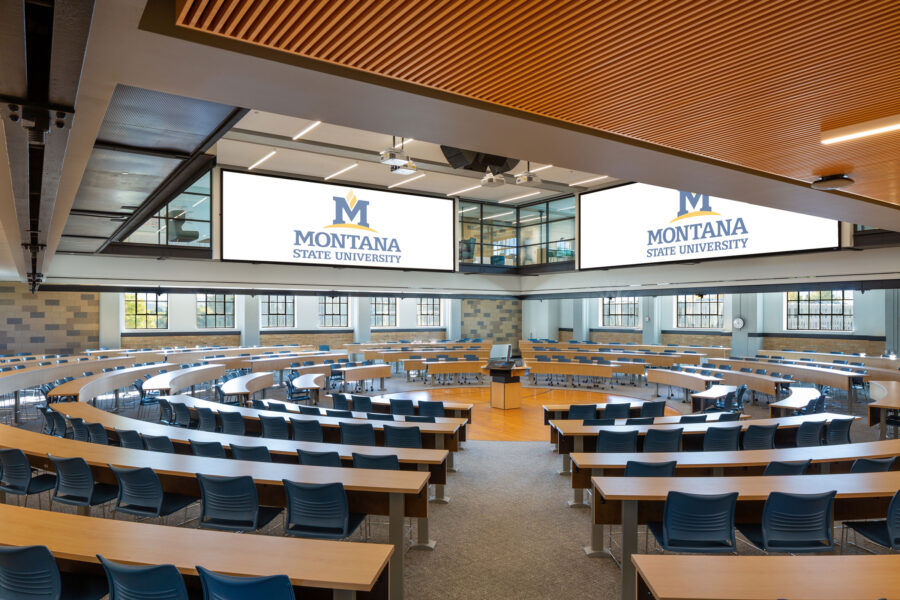
Glimpses of the past, like the gym floor, align with the goal of honoring Romney Hall’s history and celebrating the building’s evolution. Photo by Karl Neumann
“More than half of Romney’s building resources were preserved and reused, including structural elements, enclosure materials, and permanently installed interior elements,” Jim Beal, a principal owner with Cushing Terrell, previously wrote for gb&d. “More than 2,300 tons of construction waste were recycled and/or reused—ultimately diverted from the landfill.”
Marble wall panels were repurposed as decorative elements and shower stalls, while the building’s original terrazzo floors in the north stair—itself preserved as a character-defining feature—were cleaned and restored to their original condition. Hardware and suspension rods were also left exposed and inspired the metal components for the new walkway, stairs, and guardrails.
In addition to the extensive reuse of materials, the Romney Hall renovation project boasts an impressive array of sustainable features, of which include a large geothermal field, permanent carbon dioxide monitoring system, expansive lighting controls, and use of low-emitting materials—many of which bore environmental product declarations and/or material ingredient disclosure labels. The renovation also helped improve the building’s energy performance by 40.9% compared to minimum code requirements and is estimated to reduce water usage by 33% thanks to the inclusion of water-efficient fixtures.
5. Thurston Hall Renovation, Washington, D.C.
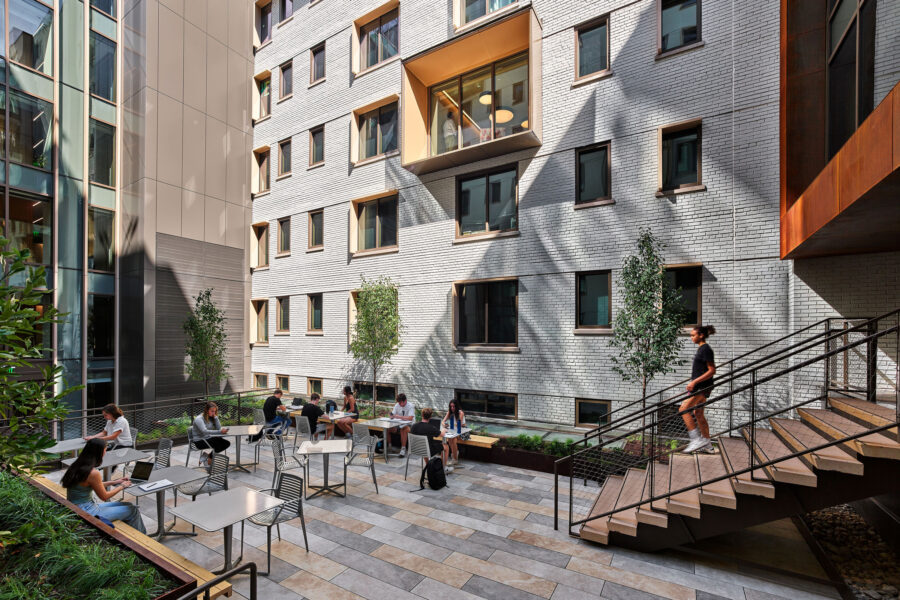
The Thurston Hall project concept is focused on two elements—the sun to the south and the students’ entrance to the north. In the middle of these two elements sits the main courtyard, around which Thurston’s student life is centered. Photo by Alan Karchmer
Just a few blocks from the White House, Thurston Hall reminds us that, in many instances, the most sustainable building is the one that already exists. Like many other projects on this list, Thurston Hall is not a completely new construct but makes use of an existing building—in this case an outdated residence hall built in 1929 that suffered from a long list of problems and architectural oversights.
Redesigned by VMDO for George Washington University, the newly renovated Thurston Hall retains many of its original components while simultaneously boasting an array of modern upgrades. “A good deal of the existing structure was reused and augmented to bring it to current standards,” Michelle Amt, director of sustainability and inclusion at VMDO, previously told gb&d. “We’re reinvigorating this old structure with new life which prepares it for another 100 years in a much more human-centric, 21st century approach to creating community in residence halls.”
- Students studying inside can see outside and feel the contagious energy from the courtyard. Photo by Alan Karchmer
- The project added more than 4,000 square feet of intensive and extensive green roofs. Plants are watered using captured rainwater. Photo by Alan Karchmer
Minimal daylighting and a dearth of community spaces were two of the major problems VMDO wanted to remedy with their redesign. Both problems were addressed in part by transforming the building’s existing lightwell into an accessible courtyard—a feat that required removing a portion of the lightwell’s south-facing facade to make room for a series of multi-level vegetated terraces. The well’s east-west facing red brick walls were painted a lighter color to help reflect sunlight deeper into the building while the addition of energy-efficient windows further served to increase the hall’s daylighting potential and reduce artificial lighting requirements.
VMDO also introduced biophilic spatial elements into the building’s design to help create a more welcoming, community-oriented environment while subtly reinforcing a connection to the natural world. Two-story kitchens, large study areas, and smaller privacy nooks provide a range of spaces for students to gather, socialize, and retreat to. “You have all these spaces of prospect and refuge that give you this aspect of security and belonging,” Amt says.
The renovation also addressed the building’s lack of proper ventilation in the form of a dedicated outdoor air system, which helped bring in fresh air and reduce indoor CO2 levels from an average of 1600 ppm to below 900 ppm. All in all, upgrades to Thurston Hall’s insulation, daylighting potential, and heating system allow the building to operate 38% more efficiently than the average residence and dining hall.
6. Martin Luther King Jr. Center, Bowie, MD
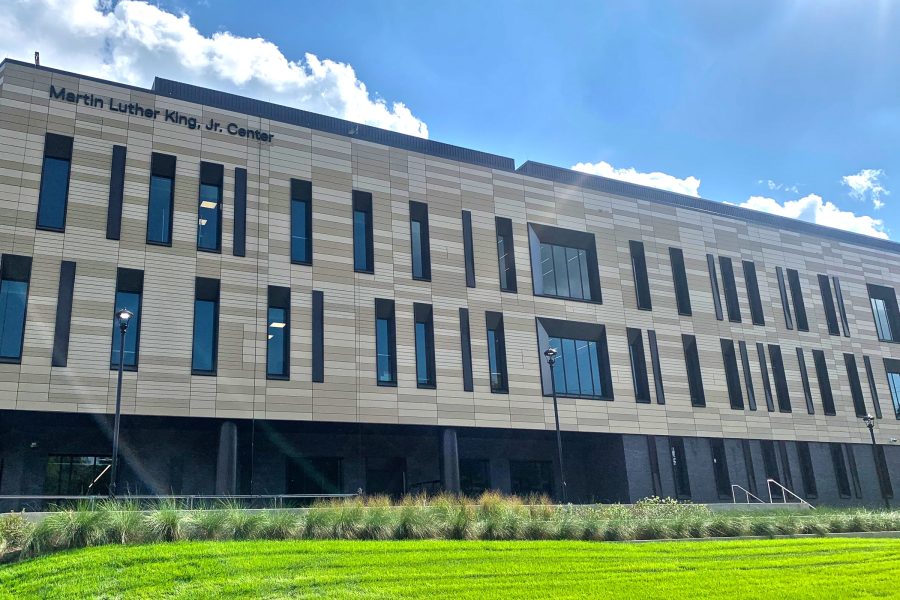
Perkins&Will designed the Bowie State University Martin Luther King, Jr. Center. Photo courtesy of Avenere Cladding
Completed in August 2024, the Martin Luther King Jr. Center is the latest addition to Bowie State University’s esteemed campus. Designed by Perkins&Will, the center aims to inspire and is home to the school’s studies in communication and media, language, literature, history, and military science.
The center’s commitment towards sustainability is immediately apparent thanks to its liberal use of thoughtful, environmentally-friendly materials like terra-cotta, which clads the entire exterior. “We talk about using thoughtful materials, and certainly this is a thoughtful project. With terra-cotta there’s a lack of environmental degradation; it has a lower carbon footprint. And there’s this incredible human history that lends itself to an intrinsic human connection to this material,” Carl Knutson, director of design at Perkins&Will, previously told gb&d.
In addition to being a low-carbon material, terra-cotta also possesses a high durability and is extremely low maintenance. The specific panels Perkins&Will chose for the project—Avenere Cladding’s NeaCera terra-cotta rainscreen panels—are lighter than other terra-cotta panels and do not require wet joints, helping to reduce lifetime costs associated with the material.
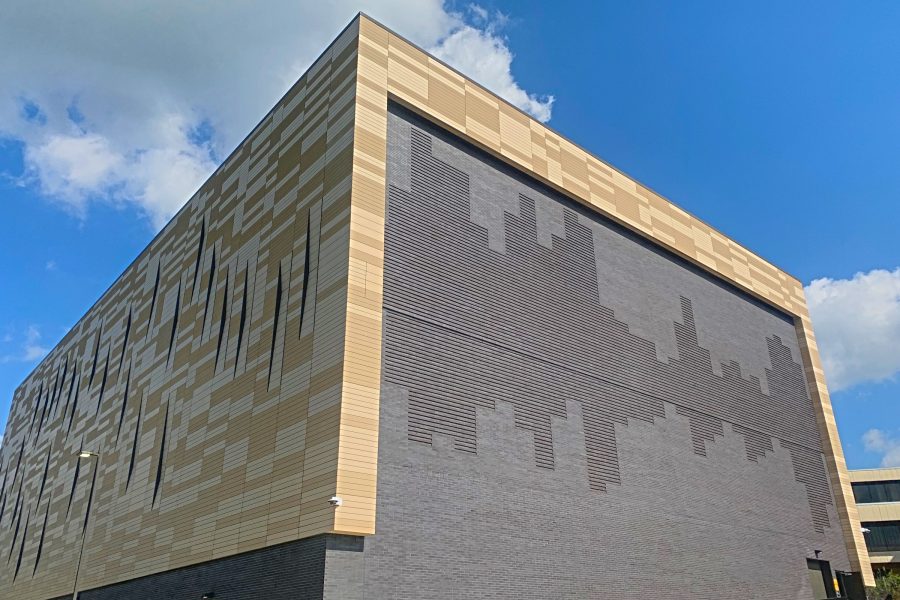
Bowie State University, part of the University System of Maryland, uses a groundbreaking terra-cotta facade. Photo courtesy of Avenere Cladding
Terra-cotta also has the advantage of being an incredibly versatile and aesthetically-pleasing material, one that supports a wide range of designs. “There is a lot of flexibility to get creative with this material, more than other materials for exterior cladding, because of the vast ability to shape the material when extruding and an expanded range of finishes. In the big picture it gave our team the ability to take on a challenge and come up with solutions,” John Stahl, vice president of sales at Avenere Cladding, previously told gb&d. “We’re doing so many unique things and as we push the envelope with one client, these creative ideas become tried and proven solutions that exceed what anyone thought the material could do.”
The center’s impressive and visually striking terra-cotta facade appears to shift colors and dimensions as the sun moves throughout the day and shadows dance across patterns created by panels of varying layers, textures, and depths. Even more impressive, however, is what those patterns actually represent—the sound wave impressions from Rev. Dr. Martin Luther King Jr.’s 1964 Nobel Peace Prize speech.
Other sustainable features include large windows for ample daylighting, usage of low-VOC products and finishes, an integrated stormwater management system, and state-of-the-art equipment/building automation system that helps ensure peak occupant comfort while maintaining a high degree of energy efficiency.
7. Thurgood Marshall Hall, Baltimore, MD
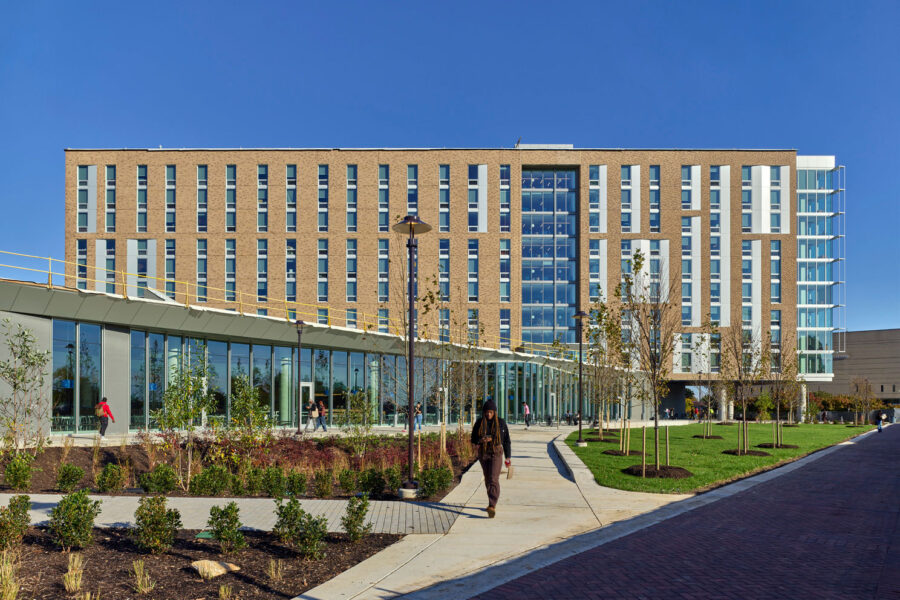
Morgan State University’s Thurgood Marshall Hall boasts a green roof and many other sustainable features. Photo by Patrick Ross
Named in honor of Baltimore native and the first African-American Associate Justice of the Supreme Court, Thurgood Marshall Hall is capable of housing over 660 students across a mix of semi-suite and apartment-style units, while also including a 40,000-square-foot dining facility.
Designed by Hord Coplan Macht in collaboration with Moody Nolan for Morgan State University—a historically Black university and the state’s preeminent urban public research university—Thurgood Marshall Hall is but one component of a campus-wide plan to increase recruitment, improve retention, and foster sustainable practices.
To ensure that the new building would meet the needs of the intended demographic, Moody Nolan conducted student focus groups and met with a diverse array of interest groups; the results of these meetings ultimately helped shape and inform the hall’s wellness-focused design.
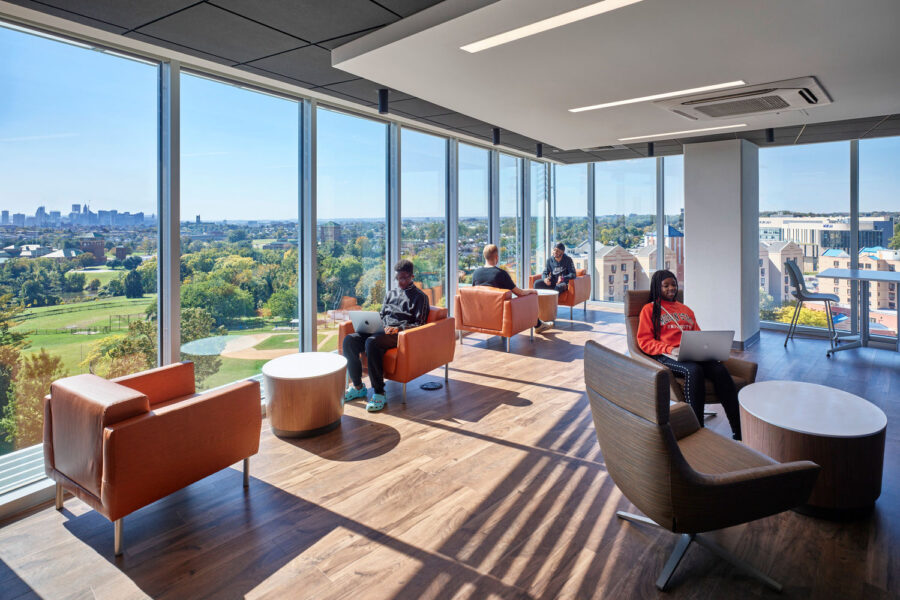
Floor-to-ceiling windows provide natural lighting with views of downtown Baltimore. Photo by Patrick Ross
A highly efficient air filtration system helps improve indoor air quality, as does the usage of low-emitting finishes. Biophilic elements—including natural materials and organic textures—can be found throughout the interior while changes in color and pattern serve as wayfinding tools. Murals and environmental graphics of Thurgood Marshall can also be found on each of the building’s residential floors.
Energy and water conservation were core to the building’s design, with ample daylighting and other energy-saving features helping to reduce energy usage by 22%; low-flow plumbing fixtures helped achieve a 35% reduction in indoor water use, while stormwater management features were implemented throughout the site to help control runoff.
“We also designed a green roof amassing more than 20,000 square feet, which contributes to reducing storm water quantity and improving the quality of the water,” Casey Smith, principal at Hord Coplan Macht, wrote in a previous gb&d article. “A selection of water conserving plumbing fixtures were also implemented within the building to contribute to a 35% reduction in indoor water use, further contributing to the overall sustainability efforts across the campus.”
8. Bergami Center, West Haven, CT
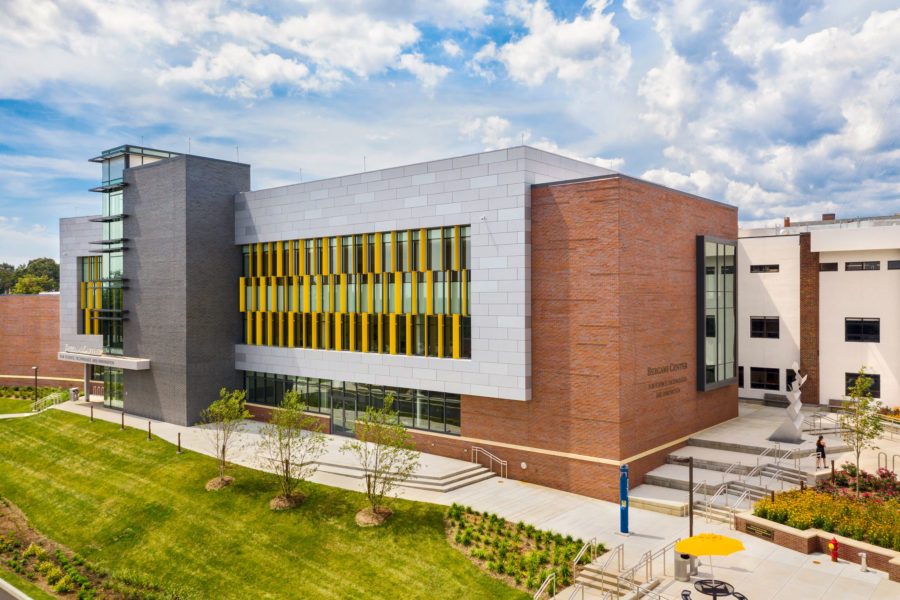
The Bergami Center is a LEED Gold certified building designed by Svigals + Partners for the University of New Haven. Photo by Peter Aaron/OTTO
When the University of New Haven (UNH) concluded in 2018 that a new academic building was needed to support campus growth, they weren’t entirely sure what kind of building would be most beneficial—so UNH, with the help of New Haven-based architectural firm Svigals + Partners, turned to the university’s stakeholder community for ideas.
“We had a stakeholder group composed of the deans of each of the schools, professors, administration, the design team—a little bit of everyone from campus,” Katelyn Chapin, associate at Svigals + Partners, told gb&d in a previous interview. “We brainstormed what types of spaces would be required for their campus. Being a community-oriented person, this was my favorite part of the process.”
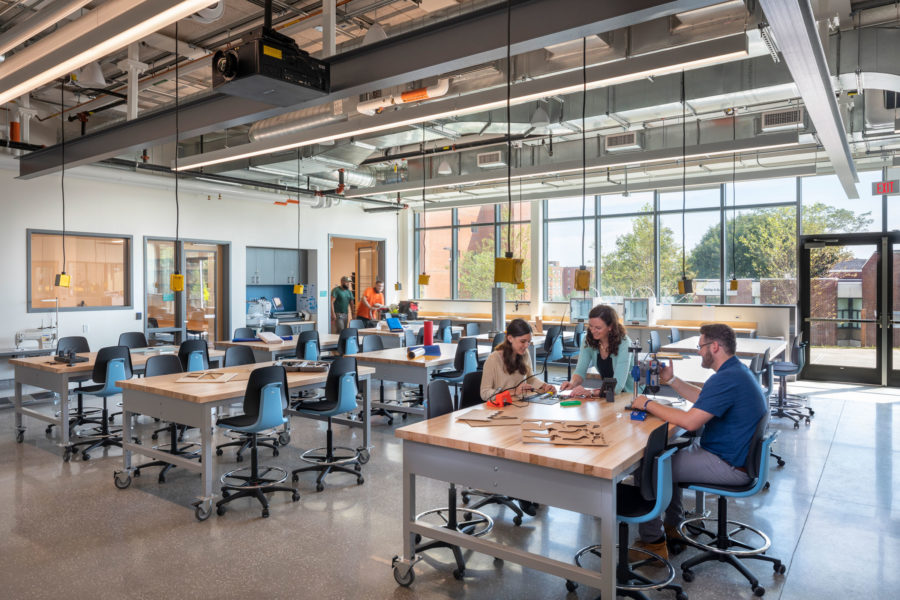
Photo by Peter Aaron/OTTO
The end result was the Bergami Center for Science, Technology, and Innovation, an interdisciplinary hub dedicated to learning, co-creation, and the betterment of society. Intended as a space where students of all majors could come to learn, create, and collaborate, the Bergami Center encompasses science classrooms, technology-supported “smart” classrooms, multimedia production studios, a makerspace, as well as an atrium and café.
From a sustainability standpoint the center features copious daylighting strategies, low-flow fixtures, high-efficiency boilers and chillers, on-demand controlled ventilation, exterior sun shades, and was partially constructed from recycled materials—all of which helped it earn LEED Gold certification.
9. Carleton University Loeb Building, Ottawa, Ontario
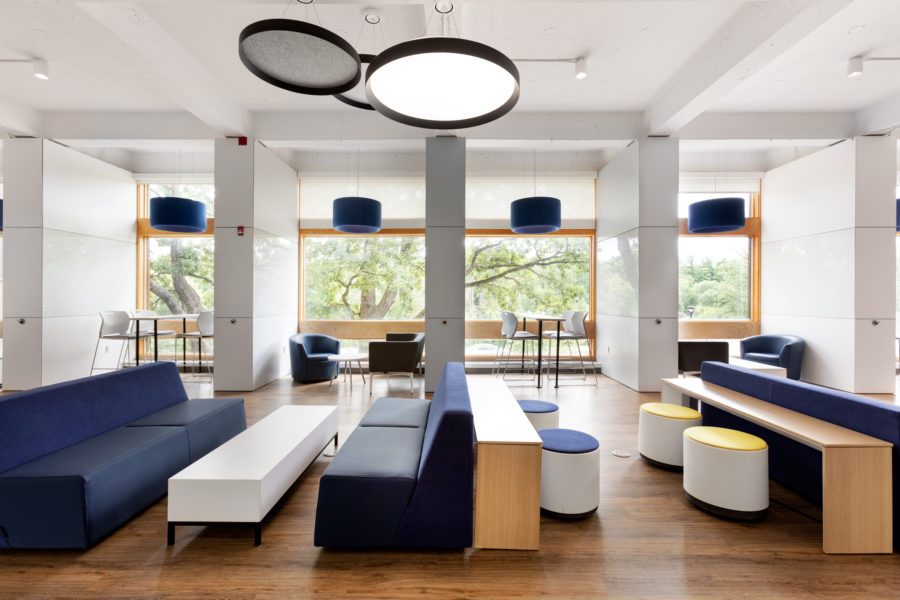
The Carleton University Loeb Building includes a new active student space designed by CSV Architects. Photo by Krista Jahnke Photography
Built in the 1960s as a student space, the Loeb Building at Carleton University in Ontario was renovated by CSV Architects in 2019 to better serve the university’s needs without getting rid of the historic elements that gave the building its character.
“Throughout the design process the intention was to pay respect to the existing exposed brick and concrete surfaces of the building and complement with carefully selected new finishes and colors,” Rick Kellner, associate at CSV Architects, told gb&d in a previous article. “The exposed brick walls and waffle slab ceiling were refreshed by applying white paint, instead of being concealed behind new finishes. The new finishes that were installed—including flooring, wall panels, and glass boards—complement the brick and concrete surfaces and highlight the original millwork of the building.”
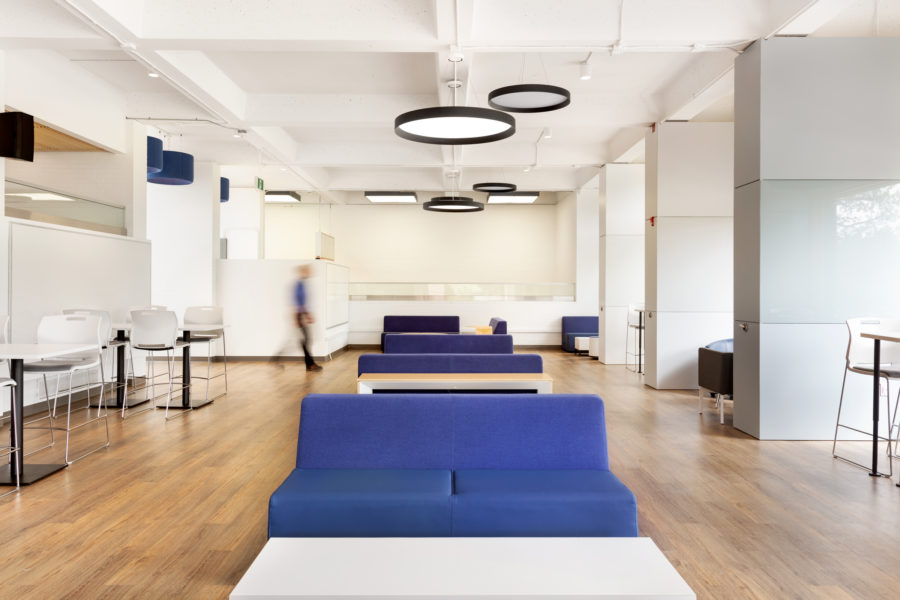
Numerous wall-mounted writing surfaces, new modular furniture, and audio-visuals allow for easy gatherings. Photo by Krista Jahnke Photography
Existing wood-framed windows—all more than 50 years old—were repaired and refurbished, a process that included the delicate refinishing of existing wood trim in places as well as the select removal and replacement of pieces when necessary. CSV even went so far as to ensure new staining matched the building’s existing window frames and trim finishes in order to maintain a cohesive historic patina between new and old elements.
CSV also implemented flexible room layouts to allow the Loeb Building to evolve and adapt as needed, introducing biophilic design elements like a wood slat ceiling and greater exposure to natural sunlight to create a space that actively fostered wellness, collaboration, and learning for both students and staff.
10. Andy Quattlebaum Outdoor Recreation Center, Clemson, SC
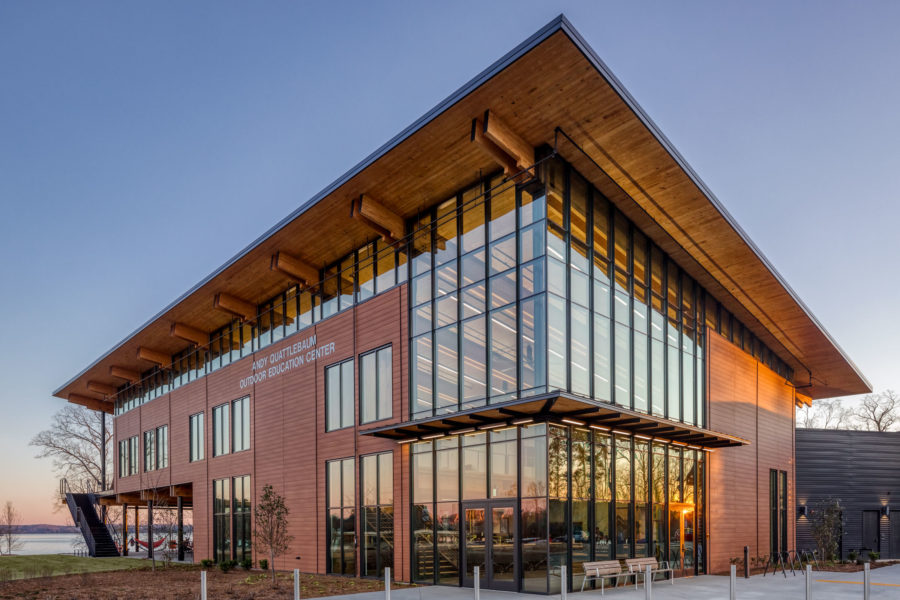
The new Andy Quattlebaum Outdoor Recreation Center at Clemson University was designed by Cooper Carry in collaboration with Clemson University’s Wood Utilization + Design Institute. Photo by Jonathan Hillyer
Designed for Clemson University by the Cooper Carry architectural firm in collaboration with the CU Wood Utilization and Design Institute, the Andy Quattlebaum Recreation Center (AQRC) aims to instill a healthy appreciation for nature at every turn.
Located on an expansive forested site with lakefront access, the AQRC is built almost entirely from ethically-sourced mass timber and is designed as two wings that stretch along the lake’s edge. Large porches and patios are located along the building to encourage outdoor socialization.
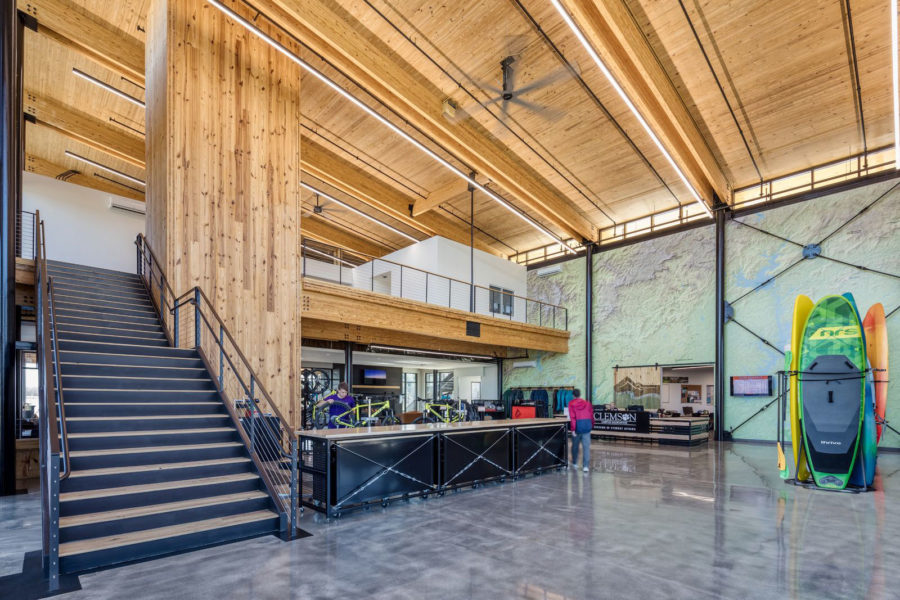
The Andy Quattlebaum Outdoor Recreation Center at Clemson University is a prominent example of a wellness-driven building, designed to emphasize natural materials—most prominently mass timber. Photo by Jonathan Hillyer
Sporting a facade wrapped in tall vertical windows, the AQRC receives plentiful sunlight throughout the year and offers stellar views of the surrounding landscape. Adequate admittance of natural sunlight was a priority for the recreation center in large part due to daylight’s role in maintaining a healthy body and mind.
No matter where you look, inside or out, you’re reminded of nature. “These biophilic elements are emphasized to encourage student wellness, activity, and interaction. We believe the center will become a hub for those looking for an on-campus escape,” Brian Campa, principal at Cooper Carry, previously told gb&d.

